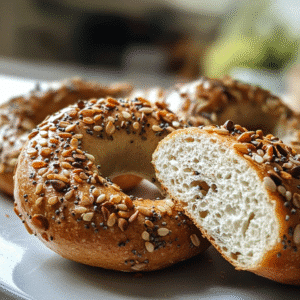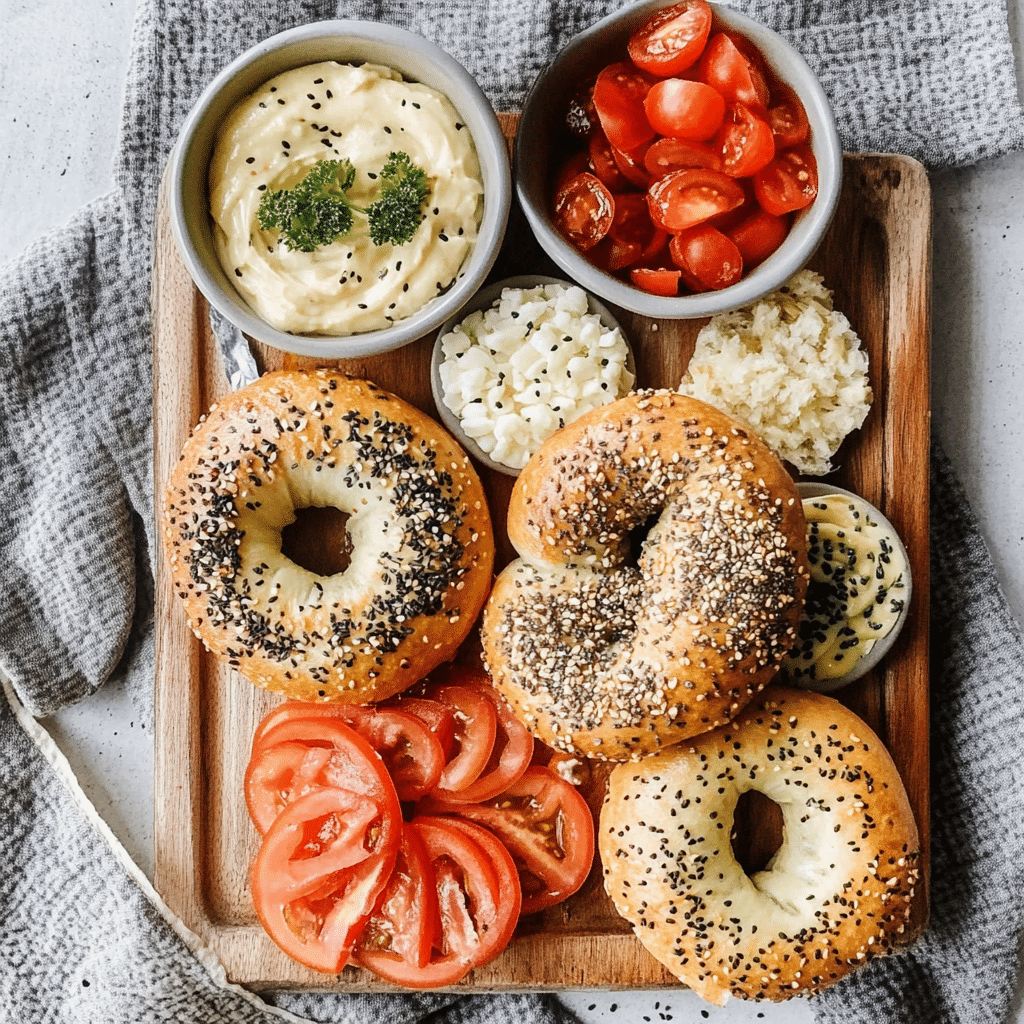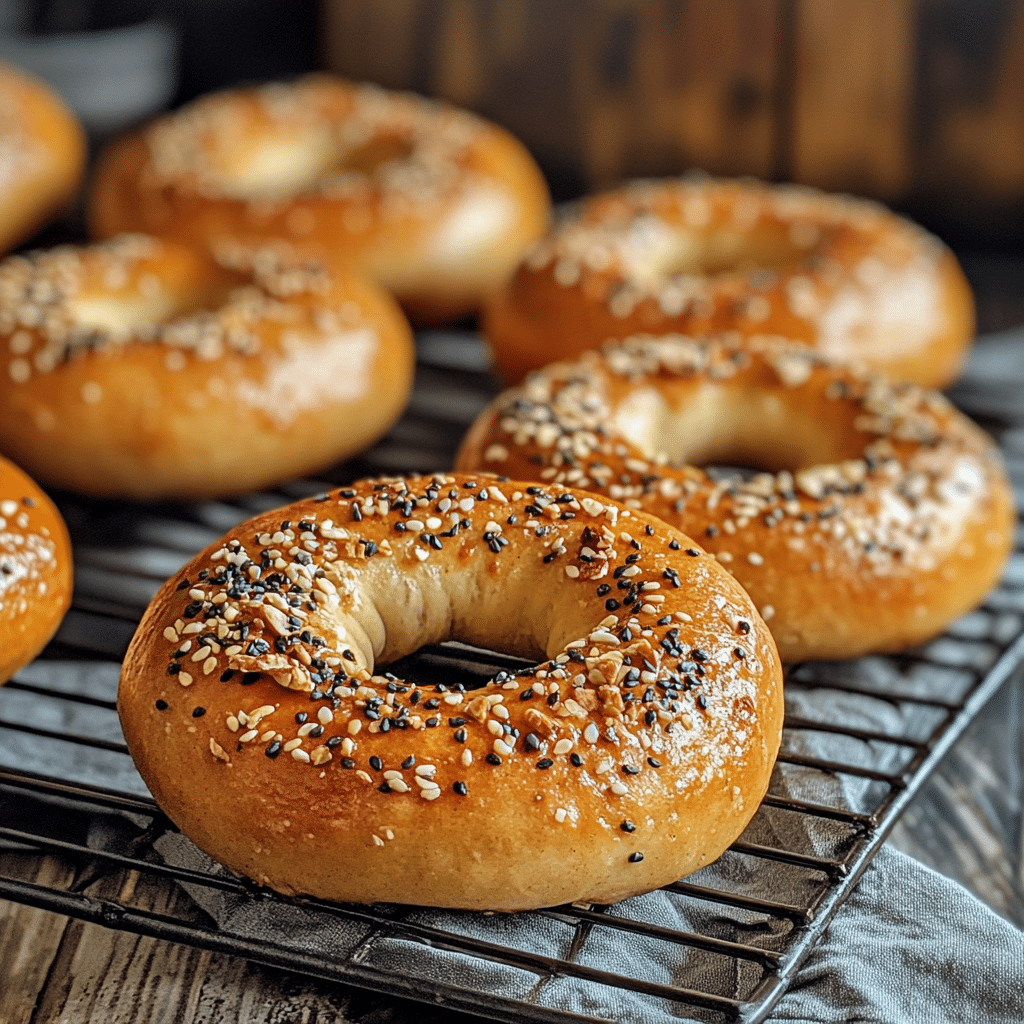Protein bagels offer a simple and tasty way to boost your nutrition without giving up the foods you love. I am Emma Thompson, a home cook from Asheville, North Carolina, passionate about creating wholesome and flavorful recipes. Since adapting my cooking to a gluten free lifestyle in 2012, I have enjoyed finding ways to make everyday favorites more nourishing.
In this guide, I will explore what makes protein bagels unique, how to enjoy them, and how they can support your health goals. You will also find answers to common questions and tips for adding these satisfying bagels to your daily routine.
Looking for inspiration? Try these delicious Cottage Cheese Bagels to boost your protein intake even more.

What Are Protein Bagels
What Makes a Bagel a Protein Bagel
A protein bagel is a higher protein version of the classic favorite. Traditional bagels are typically high in carbohydrates and lower in protein. To enhance their nutritional value, these versions use ingredients such as whey protein, pea protein, Greek yogurt, eggs, and almond flour. This means each serving can deliver anywhere from fifteen to twenty five grams of protein, significantly more than the eight to ten grams typically found in a standard bagel. They are a great choice for helping you stay full longer while supporting a balanced diet.
Table of Contents
History and Rise of High Protein Bagels
The popularity of this healthier bagel option has grown alongside fitness and clean eating trends. More consumers now seek foods with balanced macronutrients and increased protein content. Thanks to innovations in baking, you can now find these enriched bagels in grocery stores, online shops, and homemade recipes. They offer a simple and tasty way to incorporate more protein into your daily routine.

Protein Bagels Simple Homemade Recipe
Ingredients
- 1 cup plain Greek yogurt
- 1 cup self rising flour or gluten free flour blend with baking powder
- 2 scoops unflavored or vanilla protein powder (whey or plant based)
- 1 large egg, lightly beaten (for brushing)
- Toppings of choice chia seeds, sesame seeds, everything bagel seasoning
Instructions
- Preheat your oven to 375°F and prepare a baking sheet by covering it with parchment paper.
- In a large mixing bowl, combine Greek yogurt, flour blend, and protein powder. Mix until a soft dough forms.
- Transfer the dough to a lightly floured surface and knead gently until smooth and pliable.
- Divide the dough into four equal portions. Shape each portion into a round ring to form your bagels.
- Arrange the bagels on the prepared baking sheet. Brush the tops with the beaten egg and sprinkle with your chosen toppings.
- Bake for 20 to 25 minutes, or until the bagels are golden brown and cooked through.
- Allow the bagels to cool slightly on a wire rack before serving. Enjoy warm or store for later use.
Notes
- You can substitute part of the flour with almond flour to add more protein and healthy fats.
- For a vegan version, use dairy free yogurt and a flax egg, and opt for plant based protein powder.
- These bagels store well in an airtight container for up to 3 days, or can be frozen for longer storage.
Nutrition
Health Benefits of Protein Bagels
Are Protein Bagels Healthy ?
Including protein bagels in your diet can offer several health benefits, especially when compared to traditional versions. One key benefit is that meals richer in protein tend to promote a longer lasting feeling of fullness, which can help curb unnecessary snacking throughout the day.
Protein also plays an important role in supporting muscle repair and growth. Whether you are regularly active or focused on maintaining muscle mass as you age, boosting your protein intake through meals like these bagels can make a meaningful impact.
In addition, many of these bagels are crafted with more nutrient dense ingredients. They typically feature fewer refined carbs and more fiber and healthy fats, supporting better blood sugar balance and overall nutrition.
Comparing Protein Bagels vs Regular Bagels
Check out this delicious Gluten Free Mixed Berry Pie for a wholesome treat to balance your protein-packed meals.
When you compare a traditional bagel with a protein enhanced version, the differences are quite noticeable. Classic bagels are typically heavy on carbs and low in protein, often leading to quick energy spikes followed by crashes. Bagels enriched with protein help slow digestion, offering more steady energy and helping you stay satisfied longer.
Here is a quick comparison
| Nutrient | Regular Bagel | Higher Protein Bagel |
|---|---|---|
| Calories | 250 to 300 | 200 to 250 |
| Protein | 8 to 10 grams | 15 to 25 grams |
| Carbs | 50 to 60 grams | 25 to 40 grams |
| Fiber | 1 to 2 grams | 3 to 5 grams |
As shown here, switching to a higher protein option gives you a more balanced nutritional profile, which supports lasting energy and overall wellness.
Discover great ideas like these Low Carb Bagels for another protein-friendly option.

Top Bagels That Are High in Protein
What Bagels Are High in Protein
Many bagels today are crafted to boost protein content. Popular options include
- Dave’s Killer Bread Protein Bagels about 13 grams of protein
- Western Bagel Perfect 10 Bagels around 19 grams of protein
- ThinSlim Foods Protein Bagels roughly 14 grams of protein
- Lender’s Protein Bagels 10 to 12 grams of protein
- Homemade Bagels 15 to 25 grams of protein depending on ingredients
Look for bagels made with quality protein sources and minimal added sugars to get the best nutrition.
Don’t miss our Gluten Free Onion Rings for another easy and delicious recipe.
Best Brands and Options for Protein Bagels
Choosing the right option depends on your goals. If you are looking for widely available choices, brands like Lender’s and Dave’s Killer Bread can be found in most supermarkets. If you prefer more flexibility, making bagels at home gives you full control over the ingredients and allows you to customize the protein content to suit your needs.
How to Add More Protein to Your Bagels
How Do You Add Protein to Bagels
Boosting the protein content of your favorite bagel is easier than you might think. One simple method is to choose a base bagel that is already higher in protein. From there, the toppings you add can make a big difference.
Consider these ideas to increase protein
- Nut butters such as almond or peanut butter add healthy fats and extra protein.
- Greek yogurt spread is rich in protein and can be seasoned with herbs or spices.
- Smoked salmon provides lean protein and pairs well with cream cheese.
- Eggs whether scrambled, poached, or fried are a classic high protein topping.
- Cottage cheese is another protein rich option that adds a creamy texture.
These additions can easily turn your bagel into a balanced meal that supports your daily protein goals.
Best Protein Toppings and Spreads
Here is a quick guide to protein rich toppings you can mix and match
| Topping | Protein per Serving |
|---|---|
| Almond butter | 7 grams |
| Greek yogurt | 10 grams |
| Smoked salmon | 16 grams |
| Egg | 6 grams |
| Cottage cheese | 13 grams |
| Turkey slices | 8 grams |
| Tofu | 9 grams |
By combining these toppings with your bagel of choice, you can easily craft a meal that is both satisfying and protein packed.

Nutritional Profile of Popular Protein Bagels
How Much Protein Is in a Warburtons Bagel
If you are wondering about Warburtons Protein Bagels, they are a popular choice for adding more protein to your diet. A typical Warburtons Protein Bagel contains around 13 grams of protein per serving. This makes it a solid option for anyone wanting a convenient and tasty way to boost daily protein intake.
These bagels also tend to be lower in sugar compared to traditional versions, helping you maintain balanced blood sugar levels throughout the day. Always check the nutrition label, as values may vary slightly depending on the specific product line and flavor.
Macros Breakdown Calories Carbs Fats Protein
Here is a general macronutrient breakdown you can expect from many popular protein enriched bagels including options like Warburtons, Dave’s Killer Bread, and similar brands
| Nutrient | Amount per Bagel |
|---|---|
| Calories | 200 to 250 |
| Protein | 13 to 25 grams |
| Carbohydrates | 25 to 40 grams |
| Fats | 4 to 8 grams |
| Fiber | 3 to 5 grams |
| Sugars | 2 to 5 grams |
As shown in this table, choosing a higher protein bagel provides a more balanced nutritional profile compared to regular bagels, which often come with higher carb and sugar counts.
Pairing these bagels with protein rich toppings can further enhance their nutritional value, making them an excellent choice for meals and snacks.
Homemade Protein Bagels Recipes and Tips
Simple Homemade Protein Bagel Recipe
Making protein bagels at home is a rewarding way to enjoy a customizable and nutrient rich version of this popular food. Here is a simple recipe to get you started
Ingredients
- 1 cup Greek yogurt
- 1 cup self rising flour or gluten free alternative
- 2 scoops unflavored or vanilla whey protein powder
- 1 large egg beaten for brushing
- Optional toppings sesame seeds, chia seeds, everything bagel seasoning
Instructions
- Preheat your oven to 375°F and prepare a baking sheet by covering it with parchment paper.
- Combine Greek yogurt, flour blend, and protein powder in a bowl to form a dough.
- Transfer the dough to a lightly dusted work surface and softly knead it until it becomes uniform and pliable.
- Cut the dough into four portions and form each piece into a ring shape.
- Place the bagels on your baking tray. Coat them with the whisked egg and add your preferred toppings.
- Bake in the oven for around 20 to 25 minutes, or until they appear golden and firm.
- Let the bagels cool slightly before enjoying.
These homemade bagels typically provide around 15 to 20 grams of protein per serving, depending on the type of protein powder used.
Ingredient Substitutions to Boost Protein
If you want to further increase the protein content or adjust for dietary needs, consider these substitutions
- Replace part of the flour with almond flour for added protein and healthy fats.
- Use plant based protein powder for a dairy free version.
- Add chia seeds or flaxseeds to the dough for extra protein and fiber.
- Swap in quark or cottage cheese instead of Greek yogurt for a creamier texture and more protein.
Experimenting with different ingredients allows you to tailor your bagels to your nutritional preferences and flavor profile.

Protein Bagels for Different Diets
Gluten Free and Vegan Protein Bagel Options
Today’s market offers many choices for those following gluten free or vegan diets. If you are gluten sensitive or diagnosed with Celiac disease, several brands and recipes use gluten free flours combined with plant based protein sources to create a safe and satisfying option.
For example
- Gluten free protein bagels often use almond flour, coconut flour, or a gluten free all purpose blend paired with whey or plant based protein powder.
- Vegan protein bagels substitute Greek yogurt with dairy free yogurt or a flax egg and use a plant based protein powder such as pea or hemp protein.
If baking at home, these swaps make it simple to craft bagels that align with your dietary needs. When buying store bought versions, always check labels for allergen information and protein content to ensure they match your preferences.
Protein Bagels for Weight Loss and Muscle Gain
Protein bagels can support both weight loss and muscle building when included in a balanced diet.
For weight loss
- The higher protein and fiber content helps promote fullness, reducing the chance of overeating.
- Choosing lower calorie, high protein bagels paired with nutrient dense toppings supports fat loss while maintaining muscle.
For muscle gain
- The added protein supports your daily intake goals, aiding in muscle recovery and development.
- Pairing a protein rich bagel with toppings like lean meats, eggs, or cottage cheese makes an ideal post workout meal.
In both cases, protein bagels offer flexibility and convenience, making them easy to fit into a variety of nutrition plans.
Where to Buy the Best Protein Bagels
Supermarket Brands vs Artisan Bakeries
You can find protein bagels in many local grocery stores and artisan bakeries. Both options offer unique advantages.
Supermarket brands provide convenience and consistency. You will often find brands like
- Dave’s Killer Bread
- Lender’s
- Western Bagel
- ThinSlim Foods
These are great for busy schedules and are typically available in the bakery or frozen section.
Artisan bakeries often offer small batch, freshly baked protein bagels with unique flavors and ingredients. While slightly more expensive, they can deliver a fresher taste and the option to request custom ingredients or gluten free options.
When choosing between the two, consider your priorities. If convenience matters most, supermarket brands will fit the bill. If flavor and ingredient quality are key, check out local bakeries.
Online Stores and Subscription Services
If you prefer shopping from home, there are many online retailers that deliver protein bagels straight to your door. Popular options include
- Western Bagel’s official website offers subscription services for regular deliveries.
- ThinSlim Foods has a full online store with customizable bundle options.
- Amazon carries a wide selection of high protein bagel brands with quick shipping.
- Local bakeries Some offer online ordering and delivery through platforms like Goldbelly.
Shopping online allows you to explore a broader selection and access specialty items not always available in stores. Be sure to read product reviews and nutrition labels before making a choice.
FAQs About Protein Bagels
Are Protein Bagels Healthy ?
Yes, protein bagels can be a healthy choice, especially when compared to traditional bagels. Their higher protein content helps promote satiety, supports muscle health, and can contribute to a more balanced diet. Choose varieties that limit added sugars and feature nutrient dense, whole food ingredients to maximize their health benefits.
What Bagels Are High in Protein ?
Many brands now offer high protein varieties. Some top choices include Dave’s Killer Bread Protein Bagels, Western Bagel Perfect 10, and ThinSlim Foods Protein Bagels. You can also make your own at home using protein powder, Greek yogurt, and high protein flours.
How Do You Add Protein to Bagels ?
Adding protein to your bagels is simple. Use spreads like almond butter, Greek yogurt, or cottage cheese. Top with eggs, smoked salmon, turkey slices, or plant based options like tofu to further increase the protein content of your meal.
How Much Protein Is in a Warburtons Bagel ?
A Warburtons Protein Bagel typically contains about 13 grams of protein per serving. Exact amounts may vary slightly depending on the flavor or variety, so it is always a good idea to check the label for precise nutritional information.
Conclusion
Protein bagels are a delicious and simple way to add more protein to your diet. Whether you choose store bought options or make your own at home, they can help support your health goals, from improving satiety to building muscle. With so many ways to customize them, protein bagels can easily fit into any lifestyle or dietary plan. Try adding them to your meal rotation and enjoy both the flavor and the benefits.
Follow us on Facebook and Pinterest for more wholesome recipes and creative ways to enjoy protein rich meals.